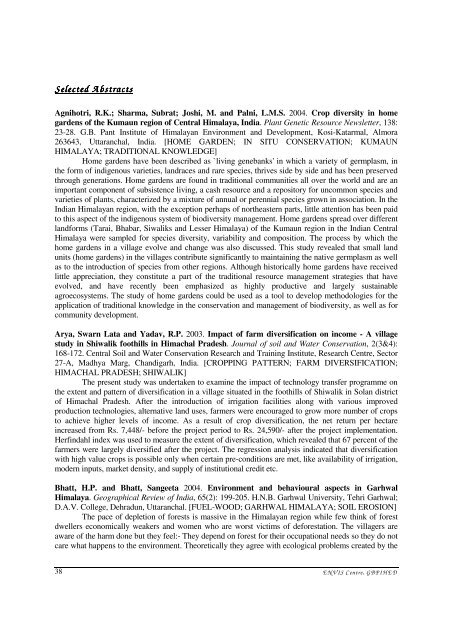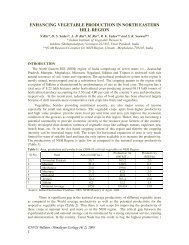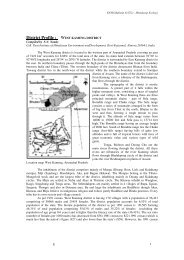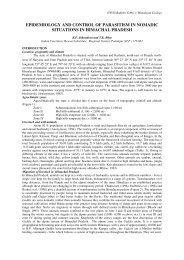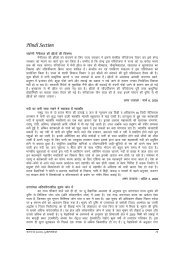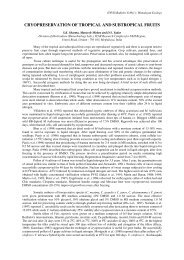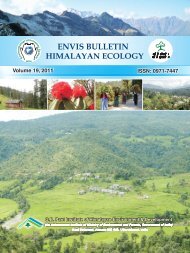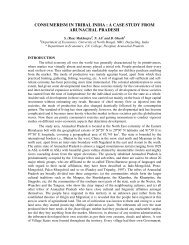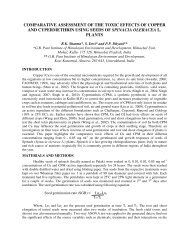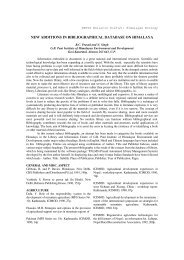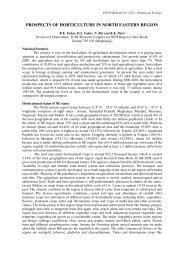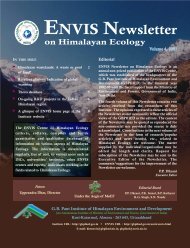Selected A bstractsAgnihotri, R.K.; Sharma, Subrat; Joshi, M. and Palni, L.M.S. 2004. Crop diversity in homegardens of the Kumaun regi<strong>on</strong> of Central Himalaya, India. Plant Genetic Resource Newsletter, 138:23-28. G.B. Pant Institute of <strong>Himalayan</strong> Envir<strong>on</strong>ment and Development, Kosi-Katarmal, Almora263643, Uttaranchal, India. [HOME GARDEN; IN SITU CONSERVATION; KUMAUNHIMALAYA; TRADITIONAL KNOWLEDGE]Home gardens have been described as `living genebanks' in which a variety of germplasm, inthe form of indigenous varieties, landraces and rare species, thrives side by side and has been preservedthrough generati<strong>on</strong>s. Home gardens are found in traditi<strong>on</strong>al communities all over the world and are animportant comp<strong>on</strong>ent of subsistence living, a cash resource and a repository for uncomm<strong>on</strong> species andvarieties of plants, characterized by a mixture of annual or perennial species grown in associati<strong>on</strong>. In theIndian <strong>Himalayan</strong> regi<strong>on</strong>, with the excepti<strong>on</strong> perhaps of northeastern parts, little attenti<strong>on</strong> has been paidto this aspect of the indigenous system of biodiversity management. Home gardens spread over differentlandforms (Tarai, Bhabar, Siwaliks and Lesser Himalaya) of the Kumaun regi<strong>on</strong> in the Indian CentralHimalaya were sampled for species diversity, variability and compositi<strong>on</strong>. The process by which thehome gardens in a village evolve and change was also discussed. This study revealed that small landunits (home gardens) in the villages c<strong>on</strong>tribute significantly to maintaining the native germplasm as wellas to the introducti<strong>on</strong> of species from other regi<strong>on</strong>s. Although historically home gardens have receivedlittle appreciati<strong>on</strong>, they c<strong>on</strong>stitute a part of the traditi<strong>on</strong>al resource management strategies that haveevolved, and have recently been emphasized as highly productive and largely sustainableagroecosystems. The study of home gardens could be used as a tool to develop methodologies for theapplicati<strong>on</strong> of traditi<strong>on</strong>al knowledge in the c<strong>on</strong>servati<strong>on</strong> and management of biodiversity, as well as forcommunity development.Arya, Swarn Lata and Yadav, R.P. 2003. Impact of farm diversificati<strong>on</strong> <strong>on</strong> income - A villagestudy in Shiwalik foothills in Himachal Pradesh. Journal of soil and Water C<strong>on</strong>servati<strong>on</strong>, 2(3&4):168-172. Central Soil and Water C<strong>on</strong>servati<strong>on</strong> Research and Training Institute, Research <str<strong>on</strong>g>Centre</str<strong>on</strong>g>, Sector27-A, Madhya Marg, Chandigarh, India. [CROPPING PATTERN; FARM DIVERSIFICATION;HIMACHAL PRADESH; SHIWALIK]The present study was undertaken to examine the impact of technology transfer programme <strong>on</strong>the extent and pattern of diversificati<strong>on</strong> in a village situated in the foothills of Shiwalik in Solan districtof Himachal Pradesh. After the introducti<strong>on</strong> of irrigati<strong>on</strong> facilities al<strong>on</strong>g with various improvedproducti<strong>on</strong> technologies, alternative land uses, farmers were encouraged to grow more number of cropsto achieve higher levels of income. As a result of crop diversificati<strong>on</strong>, the net return per hectareincreased from Rs. 7,448/- before the project period to Rs. 24,590/- after the project implementati<strong>on</strong>.Herfindahl index was used to measure the extent of diversificati<strong>on</strong>, which revealed that 67 percent of thefarmers were largely diversified after the project. The regressi<strong>on</strong> analysis indicated that diversificati<strong>on</strong>with high value crops is possible <strong>on</strong>ly when certain pre-c<strong>on</strong>diti<strong>on</strong>s are met, like availability of irrigati<strong>on</strong>,modern inputs, market density, and supply of instituti<strong>on</strong>al credit etc.Bhatt, H.P. and Bhatt, Sangeeta 2004. Envir<strong>on</strong>ment and behavioural aspects in GarhwalHimalaya. Geographical Review of India, 65(2): 199-205. H.N.B. Garhwal University, Tehri Garhwal;D.A.V. College, Dehradun, Uttaranchal. [FUEL-WOOD; GARHWAL HIMALAYA; SOIL EROSION]The pace of depleti<strong>on</strong> of forests is massive in the <strong>Himalayan</strong> regi<strong>on</strong> while few think of forestdwellers ec<strong>on</strong>omically weakers and women who are worst victims of deforestati<strong>on</strong>. The villagers areaware of the harm d<strong>on</strong>e but they feel:- They depend <strong>on</strong> forest for their occupati<strong>on</strong>al needs so they do notcare what happens to the envir<strong>on</strong>ment. Theoretically they agree with ecological problems created by the38E N V IS C entre, G B P IH E D
over use and misuse of forests but practically it is different. Powerful people want them to stay poor sothat envir<strong>on</strong>ment can be protected. They are protecting the forests other wise situati<strong>on</strong> would have beenmuch severe than existing <strong>on</strong>e.Bingeman, Kristin; Berkes, Fikret and Gardner, James S. 2004. Instituti<strong>on</strong>al resp<strong>on</strong>ses todevelopment pressures: Resilience of social-ecological systems in Himachal Pradesh, India.Internati<strong>on</strong>al Journal of Sustainable Development and World <strong>Ecology</strong>, 11(1): 99-115. NaturalResources Institute, University of Manitoba, Canada. [FOREST MANAGEMENT; RESILIENCE;SUSTAINABILITY]In the Kullu district, Himachal Pradesh, India, ec<strong>on</strong>omic and urban growth, and diversificati<strong>on</strong>have increased pressure <strong>on</strong> forests and forest-based social-ecological systems. As in many <strong>Himalayan</strong>regi<strong>on</strong>s, livelihood sustainability is linked to forest systems. As in many <strong>Himalayan</strong> regi<strong>on</strong>s, livelihoodsustainability is linked to forest resources, products and services. Recent development in the regi<strong>on</strong>, towhich these systems may be vulnerable, brings into questi<strong>on</strong> envir<strong>on</strong>mental and livelihoodsustainability. This paper examines the resilience of integrated systems of people and nature, or socialecologicalsystems, in the face of development pressures by evaluating a number of local and state-levelinstituti<strong>on</strong>al resp<strong>on</strong>ses. Resilience, which describes the ability of the social-ecological systems to adaptto change by buffering shocks, improving self organizati<strong>on</strong> and increasing capacity for learning, is anessential quality for sustainable development. Instituti<strong>on</strong>al resp<strong>on</strong>ses which positively c<strong>on</strong>tribute toresilience and sustainability include the work of mahila mandals in forest management, adopti<strong>on</strong> ofJoint Forest Management (JFM) policies and practices, upholding rules, strengthening local instituti<strong>on</strong>s,establishing firewood depots and adopting alternative energy sources. Instituti<strong>on</strong>al failures broughtabout by the lack of rule enforcement and corrupti<strong>on</strong> erodes resilience. The analysis of instituti<strong>on</strong>alresp<strong>on</strong>ses helps to identify areas where capacity exists and areas in which capacity building is needed toproduce resilient social ecological systems and therefore, sustainable development.Butola, J.S. and Badola, H.K. 2004. Seed germinati<strong>on</strong> improvement using, chemicals in Heracleumcandicans wall, A threatened medicinal herb of Himalaya. The Indian Forester, 130(5): 565-572.G.B. Pant Institute of <strong>Himalayan</strong> Envir<strong>on</strong>ment and Development, Himachal Unit, Mohal-Kullu,Himachal Pradesh. [CONSERVATION; MEDICINAL HERB; SEED GERMINATION]To meet mass multiplicati<strong>on</strong> demand in ex-situ cultivati<strong>on</strong> of Heracleum candicans (Apiaceae),a threatened medicinal herb of Himalaya, presoaking treatments of plant growth regulators and otherchemicals examined to achieve improved seed germinati<strong>on</strong>. In laboratory c<strong>on</strong>diti<strong>on</strong>, of 15 treatmentstried, GA 3 (250 µM), KNO 3 (100 mM) and NaHCIO 3 (15, 30 and 45 minutes) significantly stimulatedthe seed germinati<strong>on</strong> over c<strong>on</strong>trol. NaHCIO 3 (30-min) proved significantly best treatment for achievinghighest germinati<strong>on</strong> (81.3%) and reducing mean germinati<strong>on</strong> time over c<strong>on</strong>trol. Authors recommendedthe use of KNO 3 and NaHCIO 3 as effective and cheep stimulants to seed germinati<strong>on</strong> in massmultiplicati<strong>on</strong> and c<strong>on</strong>servati<strong>on</strong> programme for H. candicans in Himalaya.Chauhan, Permeshwar S.; Porwal, Mahesh C.; Sharma, Lalit and Negi, Jay Dev Singh 2003.Change detecting in Sal forest in Dehradun forest divisi<strong>on</strong> using remote sensing and GeographicalInformati<strong>on</strong> System. Phot<strong>on</strong>irvachak, 31(3): 211-218. Indian Institute of Remote Sensing (IIRS),Dehradun 248 001; Forest Research Institute (FRI), Dehradun 248 001, Uttaranchal, India. [GIS;MICRO-CLIMATIC CONDITION; REMOTE SENSING; SATELLITE DATA]The views of study site have revealed the change in vegetati<strong>on</strong> cover of Sal Dense to SalMedium and Sal Open in 6 forest Mosaics owing to biotic and abiotic c<strong>on</strong>diti<strong>on</strong> prevailing in thespecific areas. Analysis carried out using thematic map derived from aerial photograph of 1976 andsatellite data of IRS 1C LISS III False Colour Composite (FCC) of March 1999 revealed the cause forchange in the forest density classes. Deforestati<strong>on</strong>, encroachment and agriculture have been identified asE N V IS B ulletin : H im alayan E cology 12(2), 2004 39
- Page 6 and 7: after year (Gosh, 1984). In North E
- Page 8 and 9: Future thrustThe followings are the
- Page 10 and 11: Table 1: State wise area and produc
- Page 12 and 13: Table 2: Performance of tomato vari
- Page 14 and 15: durable, about 5-6 times costlier,
- Page 16 and 17: IS GOAT FARMING A THREAT TO ECOLOGY
- Page 18 and 19: Bank officers’ viewAll the bank o
- Page 20: FOREST FRAGMENTATION : A THREAT TO
- Page 23 and 24: (ii)(iii)(iv)Area insensitive speci
- Page 25 and 26: ability to nest in the matrix area
- Page 27 and 28: Management actionsLand management e
- Page 29 and 30: Laurance, W. F and Bierregaard, Jr.
- Page 31 and 32: Sample surveyThe present study is b
- Page 33 and 34: Agricultural sectorBiomass from agr
- Page 35 and 36: anches, roots and wood chips etc. D
- Page 37: GoI, 2001. Report of the Working Gr
- Page 41 and 42: has ensured their survival in extre
- Page 43 and 44: Kar, A. 2004. Common wild vegetable
- Page 45 and 46: test sites at Shimla and Nahan usin
- Page 47 and 48: performance for drought tolerance)
- Page 49 and 50: een assigned to different preceding
- Page 51 and 52: of Himalayan Environment and Develo
- Page 53 and 54: (2%). Total protein content varied
- Page 55 and 56: wheat flour slurry) and 'Malera' (p
- Page 57 and 58: Uniyal, V.P. 2004. Butterflies of N
- Page 59 and 60: N ew s & V iew sNumber of leopards
- Page 61 and 62: also discourage them intake thes dr
- Page 63 and 64: and fauna, Sikkim is redited with h
- Page 65 and 66: i{kksa ij v/;;u fd, tk pqds gSA Hkw
- Page 67 and 68: laLFkku caxykSj esa izksQslj fouksn
- Page 69 and 70: aa/kku dh ikjEifjd iztkfr;ksa ds la
- Page 71 and 72: aaQwyksyksaa dh ?kkVh% % ,d izLrkfo
- Page 73: dVku dks viuh ewlyknkj tM+ksa ds dk


